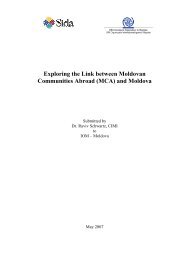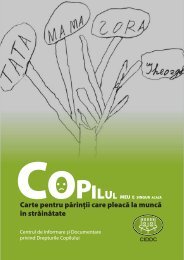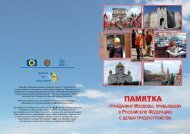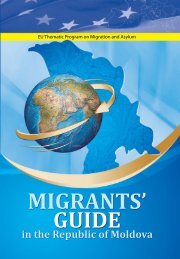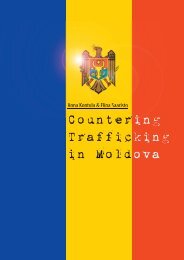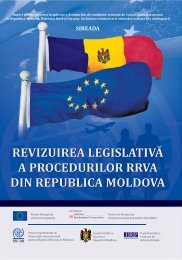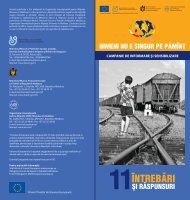Trafficking in Human Beings in Southeastern Europe - Iom
Trafficking in Human Beings in Southeastern Europe - Iom
Trafficking in Human Beings in Southeastern Europe - Iom
- No tags were found...
You also want an ePaper? Increase the reach of your titles
YUMPU automatically turns print PDFs into web optimized ePapers that Google loves.
<strong>Traffick<strong>in</strong>g</strong> <strong>in</strong> <strong>Human</strong> Be<strong>in</strong>gs<strong>in</strong> <strong>Southeastern</strong> <strong>Europe</strong>logical exam<strong>in</strong>ation, HIV and STI test<strong>in</strong>g, as well as treatment), a vocationalcourse for a period of 3 months (hairdress<strong>in</strong>g, bakery-pastry, other), counsell<strong>in</strong>gon adm<strong>in</strong>istrative, juridical, educational and vocational procedures andassistance <strong>in</strong> regard to local adm<strong>in</strong>istration and state agencies. Dur<strong>in</strong>g the firstthree months of function<strong>in</strong>g, 34 persons received transit assistance (maximum2 days) and n<strong>in</strong>e opted for longer term assistance (up to 3 months). In2001, IOM also supported the organisation of a network of local NGOs that willco-operation with them <strong>in</strong> the provision of victim assistance and re<strong>in</strong>tegration.Romania2.4.3. NGOsUntil recently, the only <strong>in</strong>stitutions directly <strong>in</strong>volved <strong>in</strong> assist<strong>in</strong>g and re<strong>in</strong>tegrat<strong>in</strong>gtrafficked women and children were NGOs. The first NGO to start workwith trafficked persons, <strong>in</strong> 1998, was Reach<strong>in</strong>g Out from Pitesti. Reach<strong>in</strong>g Outhas an on-go<strong>in</strong>g tra<strong>in</strong><strong>in</strong>g programme for 10 social workers work<strong>in</strong>g <strong>in</strong> theirshelter for trafficked women and children, and has achieved an 84 percentrate of re<strong>in</strong>tegration. They have also prepared “Standards to work with thevictims of traffick<strong>in</strong>g”.Before 2001, the Romanian NGOs operated as a network of organisations andshelters, which could provide trafficked persons with basic assistance and support.The shelters, which operate <strong>in</strong> three towns outside of Bucharest (Timisoara,Pitesti, Constanta), are small and designed <strong>in</strong> the first place for victimsof domestic violence. They are used for trafficked women and children as anemergency solution (with the exception of the Reach<strong>in</strong>g Out shelter). Prior to2001, neither NGO staff nor shelter personnel, with a few exceptions, hadbeen tra<strong>in</strong>ed to assist trafficked persons. They have developed skills andexpertise <strong>in</strong> the course of their work and at present are able to cont<strong>in</strong>ue theiractivities and share their experience with others, but are not <strong>in</strong> a position toprovide long-term support and run re<strong>in</strong>tegration programmes without additionaltra<strong>in</strong><strong>in</strong>g and support, <strong>in</strong>clud<strong>in</strong>g f<strong>in</strong>ancial support. These women’s organisationsand shelters for victims of violence were supported ma<strong>in</strong>ly by theSoros Foundation and have not benefited from the fund<strong>in</strong>g designated foranti-traffick<strong>in</strong>g activities <strong>in</strong> the region.S<strong>in</strong>ce 2001, IOM has started to build a new network of NGOs. In July 2001,IOM organised a conference “Interagency Cooperation <strong>in</strong> Fight<strong>in</strong>g and Preventionof Traffic <strong>in</strong> Women” <strong>in</strong> which 24 local NGOs participated.The “old” NGOs work<strong>in</strong>g on traffick<strong>in</strong>g have also started to organise themselves,but separately from the IOM network. The FAMNET coalition of 13 localNGOs is a network work<strong>in</strong>g <strong>in</strong> the field of victim assistance and re<strong>in</strong>tegration.Their activities <strong>in</strong>clude prevention campaigns, a hotl<strong>in</strong>e and website for organisationswith<strong>in</strong> the network, shelters for trafficked women and children (<strong>in</strong>Timisoara, Pitesti, Constanta) and re<strong>in</strong>tegration programmes, <strong>in</strong>clud<strong>in</strong>g tra<strong>in</strong><strong>in</strong>g,school<strong>in</strong>g and job tra<strong>in</strong><strong>in</strong>g. Reach<strong>in</strong>g Out will start tra<strong>in</strong><strong>in</strong>g social workersfrom FAMNET, accord<strong>in</strong>g to their “Standards” document.There is no cont<strong>in</strong>uity <strong>in</strong> the work with trafficked persons. Some of the NGOswhich had been most active dur<strong>in</strong>g the last two years <strong>in</strong> the area of victimassistance and support, are not <strong>in</strong>volved <strong>in</strong> the new projects and campaignsstarted by IOM. IOM has chosen new partner organisations, which have to betra<strong>in</strong>ed and to learn how to work with trafficked persons. The FAMNET networkof “old” NGOs is prepar<strong>in</strong>g a new programme. The tension is partially due tothe fact that the NGOs do not agree with IOM’s approach to re<strong>in</strong>tegration.FAMNET views IOM as an organisation work<strong>in</strong>g with migrants and as hav<strong>in</strong>gno expertise <strong>in</strong> develop<strong>in</strong>g or implement<strong>in</strong>g re<strong>in</strong>tegration programmes fortrafficked women. Accord<strong>in</strong>g to the NGOs, IOM’s approach is to send the47



